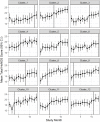Mixed effects approach to the analysis of the stepped wedge cluster randomised trial-Investigating the confounding effect of time through simulation
- PMID: 30543671
- PMCID: PMC6292598
- DOI: 10.1371/journal.pone.0208876
Mixed effects approach to the analysis of the stepped wedge cluster randomised trial-Investigating the confounding effect of time through simulation
Abstract
Background: A stepped wedge cluster randomised trial (SWCRT) is a multicentred study which allows an intervention to be rolled out at sites in a random order. Once the intervention is initiated at a site, all participants within that site remain exposed to the intervention for the remainder of the study. The time since the start of the study ("calendar time") may affect outcome measures through underlying time trends or periodicity. The time since the intervention was introduced to a site ("exposure time") may also affect outcomes cumulatively for successful interventions, possibly in addition to a step change when the intervention began.
Methods: Motivated by a SWCRT of self-monitoring for bipolar disorder, we conducted a simulation study to compare model formulations to analyse data from a SWCRT under 36 different scenarios in which time was related to the outcome (improvement in mood score). The aim was to find a model specification that would produce reliable estimates of intervention effects under different scenarios. Nine different formulations of a linear mixed effects model were fitted to these datasets. These models varied in the specification of calendar and exposure times.
Results: Modelling the effects of the intervention was best accomplished by including terms for both calendar time and exposure time. Treating time as categorical (a separate parameter for each measurement time-step) achieved the best coverage probabilities and low bias, but at a cost of wider confidence intervals compared to simpler models for those scenarios which were sufficiently modelled by fewer parameters. Treating time as continuous and including a quadratic time term performed similarly well, with slightly larger variations in coverage probability, but narrower confidence intervals and in some cases lower bias. The impact of misspecifying the covariance structure was comparatively small.
Conclusions: We recommend that unless there is a priori information to indicate the form of the relationship between time and outcomes, data from SWCRTs should be analysed with a linear mixed effects model that includes separate categorical terms for calendar time and exposure time. Prespecified sensitivity analyses should consider the different formulations of these time effects in the model, to assess their impact on estimates of intervention effects.
Conflict of interest statement
The authors have declared that no competing interests exist.
Figures








Similar articles
-
Minimum number of clusters and comparison of analysis methods for cross sectional stepped wedge cluster randomised trials with binary outcomes: A simulation study.Trials. 2017 Mar 9;18(1):119. doi: 10.1186/s13063-017-1862-2. Trials. 2017. PMID: 28279222 Free PMC article.
-
Accounting for confounding by time, early intervention adoption, and time-varying effect modification in the design and analysis of stepped-wedge designs: application to a proposed study design to reduce opioid-related mortality.BMC Med Res Methodol. 2021 Mar 16;21(1):53. doi: 10.1186/s12874-021-01229-6. BMC Med Res Methodol. 2021. PMID: 33726711 Free PMC article.
-
Design of trials for interrupting the transmission of endemic pathogens.Trials. 2016 Jun 6;17(1):278. doi: 10.1186/s13063-016-1378-1. Trials. 2016. PMID: 27266269 Free PMC article.
-
Systematic reviews of the effectiveness of day care for people with severe mental disorders: (1) acute day hospital versus admission; (2) vocational rehabilitation; (3) day hospital versus outpatient care.Health Technol Assess. 2001;5(21):1-75. doi: 10.3310/hta5210. Health Technol Assess. 2001. PMID: 11532238 Review.
-
Advancing engagement methods for trials: the CORE study relational model of engagement for a stepped wedge cluster randomised controlled trial of experience-based co-design for people living with severe mental illnesses.Trials. 2017 Apr 8;18(1):169. doi: 10.1186/s13063-017-1878-7. Trials. 2017. PMID: 28388937 Free PMC article. Review.
Cited by
-
Implementation Support for a Social Risk Screening and Referral Process in Community Health Centers.NEJM Catal Innov Care Deliv. 2023 Apr;4(4):10.1056/CAT.23.0034. doi: 10.1056/CAT.23.0034. Epub 2023 Mar 15. NEJM Catal Innov Care Deliv. 2023. PMID: 37153938 Free PMC article.
-
Bayesian Hierarchical Penalized Spline Models for Immediate and Time-Varying Intervention Effects in Stepped Wedge Cluster Randomized Trials.Stat Med. 2025 Feb 28;44(5):e10304. doi: 10.1002/sim.10304. Stat Med. 2025. PMID: 39964677 Free PMC article.
-
Promoting de-implementation of inappropriate antimicrobial use in cardiac device procedures by expanding audit and feedback: protocol for hybrid III type effectiveness/implementation quasi-experimental study.Implement Sci. 2022 Jan 29;17(1):12. doi: 10.1186/s13012-022-01186-8. Implement Sci. 2022. PMID: 35093104 Free PMC article.
-
Tuakana-teina peer education programme to help Māori elders enhance wellbeing and social connectedness.BMC Geriatr. 2024 Jan 30;24(1):114. doi: 10.1186/s12877-024-04703-0. BMC Geriatr. 2024. PMID: 38291380 Free PMC article.
-
Effects of neck-exercise and health promotion on headache outcomes in office workers: secondary analysis of the NEXpro stepped wedge cluster randomised controlled trial.J Headache Pain. 2025 Feb 12;26(1):30. doi: 10.1186/s10194-025-01963-y. J Headache Pain. 2025. PMID: 39939850 Free PMC article. Clinical Trial.
References
-
- Hemming K, Haines TP, Chilton AJ, Lilford RJ. The stepped wedge cluster randomised trial: rationale, design, analysis, and report. BMJ. 2015;350: h391 10.1136/bmj.h391 - DOI - PubMed
-
- Beard E, Lewis JJ, Copas A, Davey C, Osrin D, Baio G, et al. Stepped wedge randomised controlled trials: systematic review of studies published between 2010 and 2014. Trials. 2015;16: 353 10.1186/s13063-015-0839-2 - DOI - PMC - PubMed
-
- Mdege ND, Man M, Taylor CA, Torgerson DJ. Systematic review of stepped wedge cluster randomized trials shows that design is particularly used to evaluate interventions during routine implementation. J Clin Epidemiol. 2011;64: 936–948. 10.1016/j.jclinepi.2010.12.003 - DOI - PubMed
-
- Barker D, McElduff P, D’Este C, Campbell MJ. Stepped wedge cluster randomised trials: a review of the statistical methodology used and available. BMC Med Res Methodol. 2016;16: 69 10.1186/s12874-016-0176-5 - DOI - PMC - PubMed
-
- De Allegri M, Pokhrel S, Becher H, Dong H, Mansmann U, Kouyaté B, et al. Step-wedge cluster-randomised community-based trials: An application to the study of the impact of community health insurance. Health Res Policy Syst. 2008;6: 10 10.1186/1478-4505-6-10 - DOI - PMC - PubMed
Publication types
MeSH terms
LinkOut - more resources
Full Text Sources

